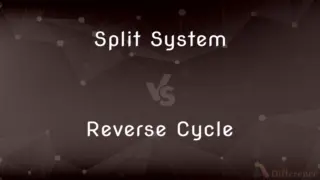Tempest vs. Hurricane — What's the Difference?
By Tayyaba Rehman & Urooj Arif — Updated on May 2, 2024
A tempest is a violent storm, with strong winds, possibly accompanied by rain, hail, or snow, while a hurricane is a specific type of storm characterized by a low-pressure center, a closed low-level atmospheric circulation, and strong winds.

Difference Between Tempest and Hurricane
Table of Contents
ADVERTISEMENT
Key Differences
A tempest is broadly defined as any violent storm with wind, and it can include thunderstorms, snowstorms, or windstorms, whereas a hurricane specifically refers to a tropical cyclone with winds exceeding 74 miles per hour, occurring in the Atlantic or Northeast Pacific.
While a tempest can occur in various environments and does not require a particular temperature or oceanic condition, hurricanes specifically form over warm tropical oceans and derive energy from the evaporation of seawater followed by condensation.
Tempests are not geographically confined and can occur in many regions worldwide, including land and coastal areas, whereas hurricanes are typically confined to tropical and subtropical ocean regions and impact coastal and inland areas via intense wind and rain.
Tempests do not follow a seasonal pattern and can arise unexpectedly depending on local weather conditions, while hurricanes are predominantly seasonal, occurring from June to November in the Atlantic and varying slightly in other regions.
The scale of a tempest can vary from local to regional, affecting a relatively smaller area compared to hurricanes, which can have wide-ranging impacts across multiple regions and cause significant coastal and inland damage due to their size and power.
ADVERTISEMENT
Comparison Chart
Definition
A violent storm of any kind
A tropical cyclone with high winds
Requirements
No specific environmental needs
Warm ocean waters, specific winds
Geographic Range
Global, including land and sea
Primarily tropical ocean regions
Seasonality
Non-seasonal
Seasonal, mainly June to November
Typical Duration
Can be brief or extended
Longer, sustained over days
Compare with Definitions
Tempest
(Literary) A tumultuous outburst.
His sudden departure caused a tempest in the family.
Hurricane
A tropical cyclone with winds of 74 mph or higher.
The hurricane caused extensive damage along the coastline.
Tempest
A severe storm with high winds.
The tempest brought down several old trees in our neighborhood.
Hurricane
(Figurative) A forceful, energetic person or movement.
She stormed into the meeting like a hurricane.
Tempest
Any violent disturbance, like a storm.
The political debate turned into a tempest of accusations and denials.
Hurricane
A rapidly rotating storm system characterized by a low-pressure center.
The hurricane's eye passed directly over the island.
Tempest
(Historical/Literary) A stormy or windy condition.
Navigating the tempest was the ship captain's greatest challenge.
Hurricane
(Historical) A storm with a violent wind, in particular a tropical cyclone.
The settlers braced for the approaching hurricane.
Tempest
A violent commotion or disturbance.
The scandal was a tempest that shook the foundations of the corporation.
Hurricane
Any wind blowing at hurricane speed.
The sails could not withstand the hurricane-force winds.
Tempest
A violent windstorm, frequently accompanied by rain, snow, or hail.
Hurricane
A severe tropical cyclone having winds greater than 64 knots (74 miles per hour; 119 kilometers per hour), originating in the equatorial regions of the Atlantic Ocean or Caribbean Sea or eastern regions of the Pacific Ocean, traveling north, northwest, or northeast from its point of origin, and usually involving heavy rains.
Tempest
Furious agitation, commotion, or tumult; an uproar
"The tempest in my mind / Doth from my senses take all feeling" (Shakespeare).
Hurricane
A wind with a speed greater than 64 knots (74 miles per hour; 119 kilometers per hour per hour), according to the Beaufort scale.
Tempest
To cause a tempest around or in.
Hurricane
Something resembling a hurricane in force or speed.
Tempest
A storm, especially one with severe winds.
Hurricane
A severe tropical cyclone in the North Atlantic Ocean, Caribbean Sea, Gulf of Mexico, or in the eastern North Pacific off the west coast of Mexico, with winds of 119 km/h (74 miles per hour) or greater accompanied by rain, lightning, and thunder that sometimes moves into temperate latitudes.
Tempest
Any violent tumult or commotion.
Hurricane
(meteorology) A wind scale for quite strong wind, stronger than a storm
Tempest
(obsolete) A fashionable social gathering; a drum.
Hurricane
"full—triple-full—full" – an acrobatic maneuver consisting of three flips and five twists, with one twist on the first flip, three twists on the second flip, one twist on the third flip
Tempest
To storm.
Hurricane
A violent storm, characterized by extreme fury and sudden changes of the wind, and generally accompanied by rain, thunder, and lightning; - especially prevalent in the East and West Indies. Also used figuratively.
Like the smoke in a hurricane whirl'd.
Each guilty thought to me isA dreadful hurricane.
Tempest
To disturb, as by a tempest.
Hurricane
A severe tropical cyclone usually with heavy rains and winds moving a 73-136 knots (12 on the Beaufort scale)
Tempest
An extensive current of wind, rushing with great velocity and violence, and commonly attended with rain, hail, or snow; a furious storm.
[We] caught in a fiery tempest, shall be hurled,Each on his rock transfixed.
Tempest
Fig.: Any violent tumult or commotion; as, a political tempest; a tempest of war, or of the passions.
Tempest
To disturb as by a tempest.
Part huge of bulkWallowing unwieldy, enormous in their gait,Tempest the ocean.
Tempest
To storm.
Tempest
A violent commotion or disturbance;
The storms that had characterized their relationship had died away
It was only a tempest in a teapot
Common Curiosities
Can a tempest include snow?
Yes, a tempest can include snow if it occurs as a violent snowstorm.
How long can a hurricane last?
A hurricane can last for more than a week as it moves across the ocean and land.
Which is more dangerous, a tempest or a hurricane?
While both can be dangerous, hurricanes generally cause more widespread damage due to their size, power, and prolonged impact.
What is the main difference between a tempest and a hurricane?
A tempest refers to any violent storm, while a hurricane is a specific type of storm characterized by tropical cyclone conditions and significant wind speeds.
What measures can be taken to prepare for a hurricane?
Preparing for a hurricane involves securing property, preparing evacuation plans, and stocking up on emergency supplies.
Where do hurricanes typically form?
Hurricanes typically form over warm tropical oceans.
Is a tempest limited to specific seasons?
No, tempests can occur at any time of the year and are not season-specific.
How are hurricanes named?
Hurricanes are named from predetermined lists organized by the World Meteorological Organization.
What are the economic impacts of hurricanes compared to tempests?
Hurricanes typically have a more substantial economic impact due to the extensive damage they can cause over larger areas.
Can hurricanes affect regions far from the ocean?
Yes, hurricanes can cause significant rainfall and flooding far inland.
Can technology predict tempests and hurricanes accurately?
Hurricanes are more predictable due to modern meteorological technology, whereas tempests can be more sudden and less predictable.
How do local governments typically respond to an approaching hurricane?
Local governments issue evacuations, activate emergency plans, and coordinate with state and federal agencies for disaster response.
Are there historical records of tempests like there are for hurricanes?
While specific storms and hurricanes may be well-documented, tempests, being a more general term, are less frequently recorded in detail.
Do tempests have a classification system like hurricanes?
No, tempests do not have a standardized classification system like hurricanes.
What is the scale used to classify hurricanes?
Hurricanes are classified on the Saffir-Simpson Hurricane Wind Scale, which ranges from Category 1 to 5.
Share Your Discovery

Previous Comparison
Straddle vs. Astride
Next Comparison
Interred vs. InternedAuthor Spotlight
Written by
Tayyaba RehmanTayyaba Rehman is a distinguished writer, currently serving as a primary contributor to askdifference.com. As a researcher in semantics and etymology, Tayyaba's passion for the complexity of languages and their distinctions has found a perfect home on the platform. Tayyaba delves into the intricacies of language, distinguishing between commonly confused words and phrases, thereby providing clarity for readers worldwide.
Co-written by
Urooj ArifUrooj is a skilled content writer at Ask Difference, known for her exceptional ability to simplify complex topics into engaging and informative content. With a passion for research and a flair for clear, concise writing, she consistently delivers articles that resonate with our diverse audience.














































